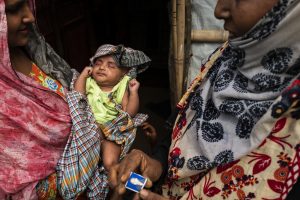Sixteen-year-old Abul* has lived most of his life in fear. As a Rohingya child growing up in Rakhine State in Myanmar, he was routinely harassed, tormented, and abused. He saw his mother and sister get beaten up, and he and his friends were arrested and tortured by police.
Just over 18 months ago, at the age of just 15, Abul left his family behind and escaped to Malaysia in the hope of building a better life. But Malaysia does not recognize Rohingya or other people fleeing to the country as refugees, and, without documents and forbidden from going to school or working, he lives in constant fear of being arrested.
“Ever since I arrived, I’ve been afraid,” he said. “I don’t go outside of the house if I don’t need to… I’m afraid of police and of being arrested.”
Abul has good reason to feel afraid. Just this week, human rights groups condemned a poster by Malaysia’s immigration department that portrayed Rohingya refugees as a national security threat. It came shortly after the government announced that it would detain undocumented refugees.
It’s a story that is familiar to hundreds of thousands of Rohingya children across Asia, who are forced to live on the fringes of society – a situation that can and should not continue. As long as they cannot safely return to their homes in Myanmar, their safety must be protected by the authorities in their countries of refuge.
There are at least 700,000 Rohingya children across the continent, the majority of whom live outside their home country, Myanmar. Most notable are the half a million children living in refugee camps in Bangladesh, where hundreds of thousands of Rohingya people fled to from Myanmar to escape violence by the Myanmar military in 2017.
This was just the latest chapter in a long story of abuse: for decades, large numbers of Rohingya have sought refuge in other Asian countries.
A new report by Save the Children highlights the plight of Rohingya children in five countries across Asia: Myanmar, Bangladesh, Malaysia, Thailand, and Indonesia. All of these children have one thing in common: Wherever they are and wherever they go, they live on the margins, at constant risk of arrest, abuse, and exploitation.
With the magnitude of atrocities they have faced, Rohingya children are among the most persecuted in the world. Some are so desperate that they risk deadly sea journeys to build a better life elsewhere. At least 2,400 Rohingya people took to boats last year, according to the U.N. Refugee Agency. At least 200 are thought to have died at sea, while more than a third of the survivors were children.
Children rescued from boats tell us they’ve spent months at sea with hardly any food or water, or saw their families beaten or thrown overboard.
One 11-year-old girl, whose boat arrived in Indonesia in September last year, told us: “We were at sea for months. I wanted to drink but there was not enough water. There was no food. I couldn’t move because the boat was so small. I was sad and exhausted.”
Tragically, even those who make it to neighboring countries face a bleak future. Our report finds that countries that should be safe havens for Rohingya children often fail to protect them.
The problems for Rohingya children start in Myanmar, even if they have never set foot on their home soil. Myanmar does not recognize the Rohingya as citizens, and none of the other four countries in practice grant citizenship to Rohingya children born on their shores; nor are they officially recognized as refugees.
With nowhere to call home, and unwelcome in the countries where they seek refuge, Rohingya children face injustice at every turn. They are more often than not denied their most basic rights to quality education and healthcare. In many places they are demonized or treated as criminals, afraid to leave their homes in case they are detained and deported as “illegal immigrants.”
Rohingya children tell us that, more than anything else, they want the chance to go to school and build a better future. Yet nearly everywhere they go, Rohingya children are blocked from education, either because of discriminatory rules or because policies that should allow them to go to school are not enforced. In Thailand and Indonesia, for example, refugee children have the right to go to school, but enforcement of the rules can be patchy and Rohingya children continue to slip through the net.
This cannot continue.
The world can – and must – do more to help Rohingya children. The military coup in Myanmar in February has added to an already precarious situation for children in the country. Governments everywhere – in Asia and beyond – must push Myanmar to end the root causes of the abuse against Rohingya. One key place to start is to support international justice processes: those who have committed atrocities against Rohingya boys, girls, and their families must be held to account.
The international community must also step up and provide funding to support Rohingya refugees everywhere. And governments in the region also have the responsibility to guarantee the rights, safety, dignity, and humanity of Rohingya children living within their borders, to ensure that they are able to survive and thrive as a community.
Because no child, wherever they are, should grow up living in fear.
*Name changed to protect identity.

































